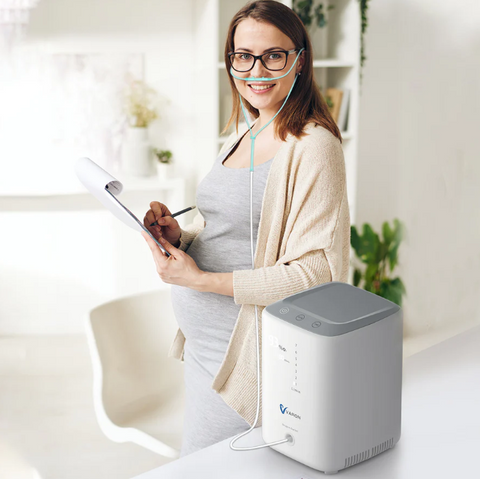
What is an Oxygen Concentrator? Understanding Its Environmental Footprint
For individuals suffering from respiratory conditions like COPD, chronic bronchitis, and sleep apnea, oxygen concentrator play a vital role in maintaining healthy oxygen levels. But what is an oxygen concentrator? These medical devices work by drawing in ambient air, which is roughly 21% oxygen, and separating it from nitrogen, the primary gas component (78%). This process concentrates the oxygen to a level of 90-95%, which is then delivered to the user through nasal prongs or a mask.
What is an Oxygen Concentrator?
An oxygen concentrator is a medical device that extracts oxygen from the surrounding air. It works by filtering out nitrogen, leaving behind concentrated oxygen (usually around 90-95%) for inhalation. This oxygen-enriched air is delivered through nasal prongs or a mask, helping individuals with low blood oxygen levels breathe more easily.
Environmental Impact of Oxygen Concentrator

While oxygen concentrators are lifesavers for many, their environmental impact, particularly through atomization, raises concerns. Atomization, the process of breaking down liquids into mist, is often used in oxygen concentrators to deliver medication through nebulizers. However, conventional atomization techniques can contribute to air pollution and energy consumption.
The innovative VH-3 Oxygen Concentrator from Varon addresses these concerns by incorporating an eco-friendly atomization system with a rate of >=0.2ml/min. This system effectively delivers medication in a fine mist while minimizing:
- Energy consumption: The VH-3 utilizes advanced technology to ensure efficient atomization, reducing overall energy usage compared to traditional methods.
- Air pollution: The optimized atomization process minimizes the release of fine particles into the air, contributing to cleaner and healthier surroundings.
Introducing the VH-3 Oxygen Concentrator

1-7L/Min Home Oxygen Concentrator VH-3
Varon recognizes the importance of sustainability and strives to offer eco-friendly solutions. The VH-3 Oxygen Concentrator is a testament to this commitment. Here's how the VH-3 minimizes its environmental footprint:
- High-Efficiency Lithium Sieve: This innovative technology ensures strong oxygen adsorption and yield, requiring less energy to maintain a consistent oxygen flow.
- Pure Copper Oil-Free Compressor: Unlike traditional compressors, the VH-3 utilizes an oil-free design, reducing energy consumption and minimizing environmental impact.
- Low Noise Operation: The quiet operation of the VH-3 (42 dB) not only promotes a peaceful environment but also signifies efficient energy usage.
Beyond Sustainability: Features of the VH-3:

The VH-3 goes beyond environmental consciousness, offering a comprehensive and user-friendly experience:
- Compact and Portable: Weighing only 10.58 lbs, the VH-3 is the lightest and smallest home oxygen concentrator from Varon, making it easy to move around or use in your car.
- Adjustable Oxygen Flow: The flow rate can be adjusted from 1-7 liters per minute to cater to individual needs.
- Integrated Nebulizer Function: The VH-3 eliminates the need for separate nebulizers, providing both oxygen therapy and medication delivery for added convenience.
- Automatic Humidification: This feature eliminates the need for manual water addition, ensuring comfortable and irritation-free oxygen therapy.
- Easy-to-Use Interface: The large panel and hidden display make operation simple for users of all ages.
- Additional Features: The VH-3 boasts an SOS function, timer operation, infrared remote control, and sleep mode for enhanced convenience.
Deep Dive: Minimizing the Environmental Impact of Your Oxygen Concentrator
Oxygen concentrators are lifesavers for many people, but their constant electricity use can raise concerns about their environmental footprint. Here's a closer look at the strategies mentioned previously and additional tips to lessen the impact:
Energy Efficiency
- Compare Models: Research the power consumption (measured in watts) of different concentrator models. Choosing a model with a lower wattage rating indicates it will use less electricity.
- Consider Flow Rates: Oxygen concentrators deliver oxygen at various flow rates, measured in liters per minute (LPM). Work with your doctor to determine the minimum effective flow rate that meets your needs. Using a lower flow rate translates to lower energy consumption.
Placement and Maintenance
- Cool and Ventilated: Position your concentrator in a cool, well-ventilated area of your home, ideally away from direct sunlight and heat sources. Good airflow helps the concentrator function efficiently and prevents overheating, which can force it to work harder and use more energy. Aim for a room temperature between 68°F and 77°F (20°C and 25°C).
- Regular Cleaning: Just like any electronic device, dust buildup can affect your concentrator's performance. Follow the manufacturer's instructions for cleaning the air intake filter and external vents regularly. A clean filter allows for optimal airflow, improving efficiency and potentially reducing energy consumption.
- Filter Replacements: Clogged or dirty filters can significantly impact performance. Replacing filters according to the manufacturer's recommendations ensures your concentrator operates efficiently and avoids unnecessary energy use.
Power Source
- Renewable Energy: While not always feasible for everyone, consider exploring renewable energy options for your home. Installing solar panels can significantly reduce your reliance on the traditional grid and indirectly lessen the environmental impact of your oxygen concentrator. Even a partial switch to solar power can make a difference.
Additional Tips
- Turn it Off When Not in Use: If you're not using your oxygen concentrator for an extended period, consider turning it off to avoid unnecessary power consumption. However, always consult your doctor regarding appropriate usage times.
- Conserve Power Throughout Your Home: Implementing general energy-saving practices throughout your home can indirectly benefit your oxygen concentrator. This includes switching off lights and electronics when not in use, using energy-efficient appliances, and adjusting your thermostat settings.
Remember, even small changes can make a difference! By following these tips and consulting your doctor, you can ensure you receive the oxygen therapy you need while minimizing the environmental impact of your oxygen concentrator.
Conclusion
The VH-3 Oxygen Concentrator from Varon represents a significant step forward in sustainable respiratory care solutions. By combining high performance, eco-friendly design, and user-centric features, the VH-3 empowers individuals to manage their respiratory health while minimizing their environmental impact.
To learn more about the VH-3 Oxygen Concentrator and explore Varon's commitment to sustainable healthcare solutions, visit our website or contact us today.















Hinterlasse einen Kommentar